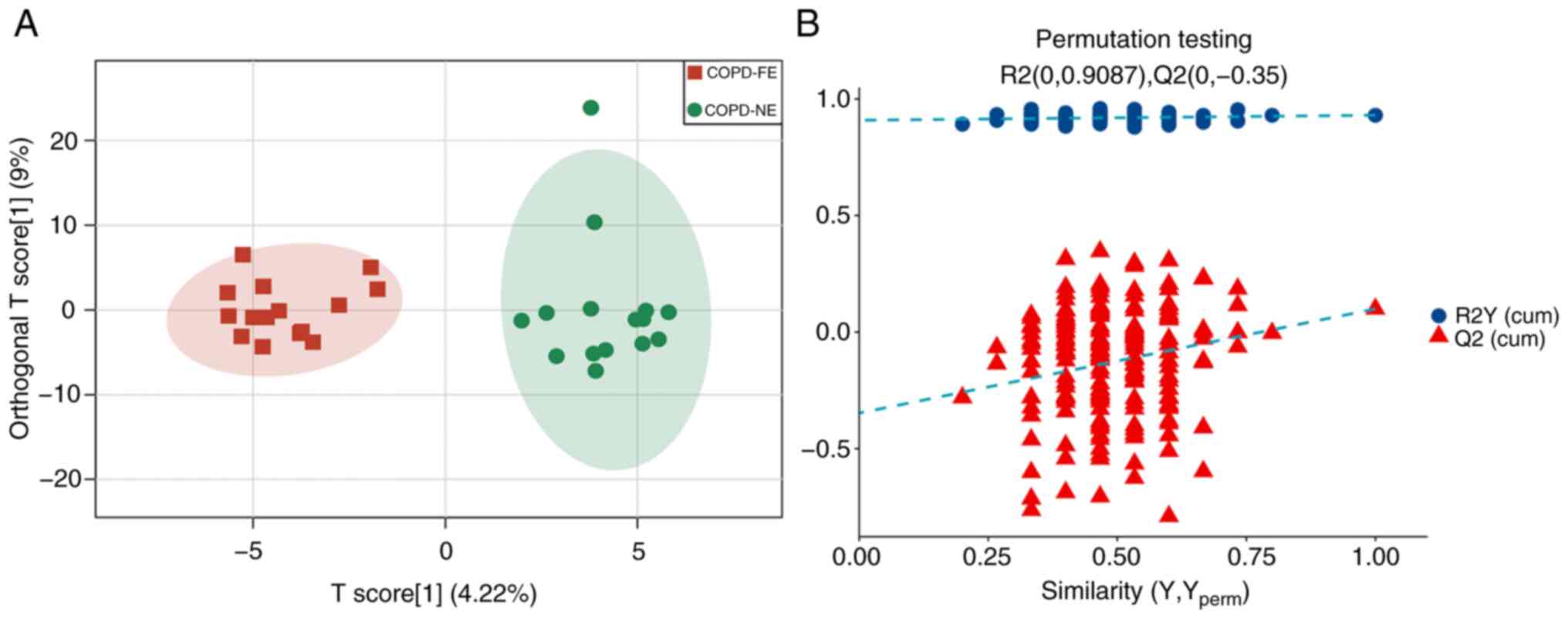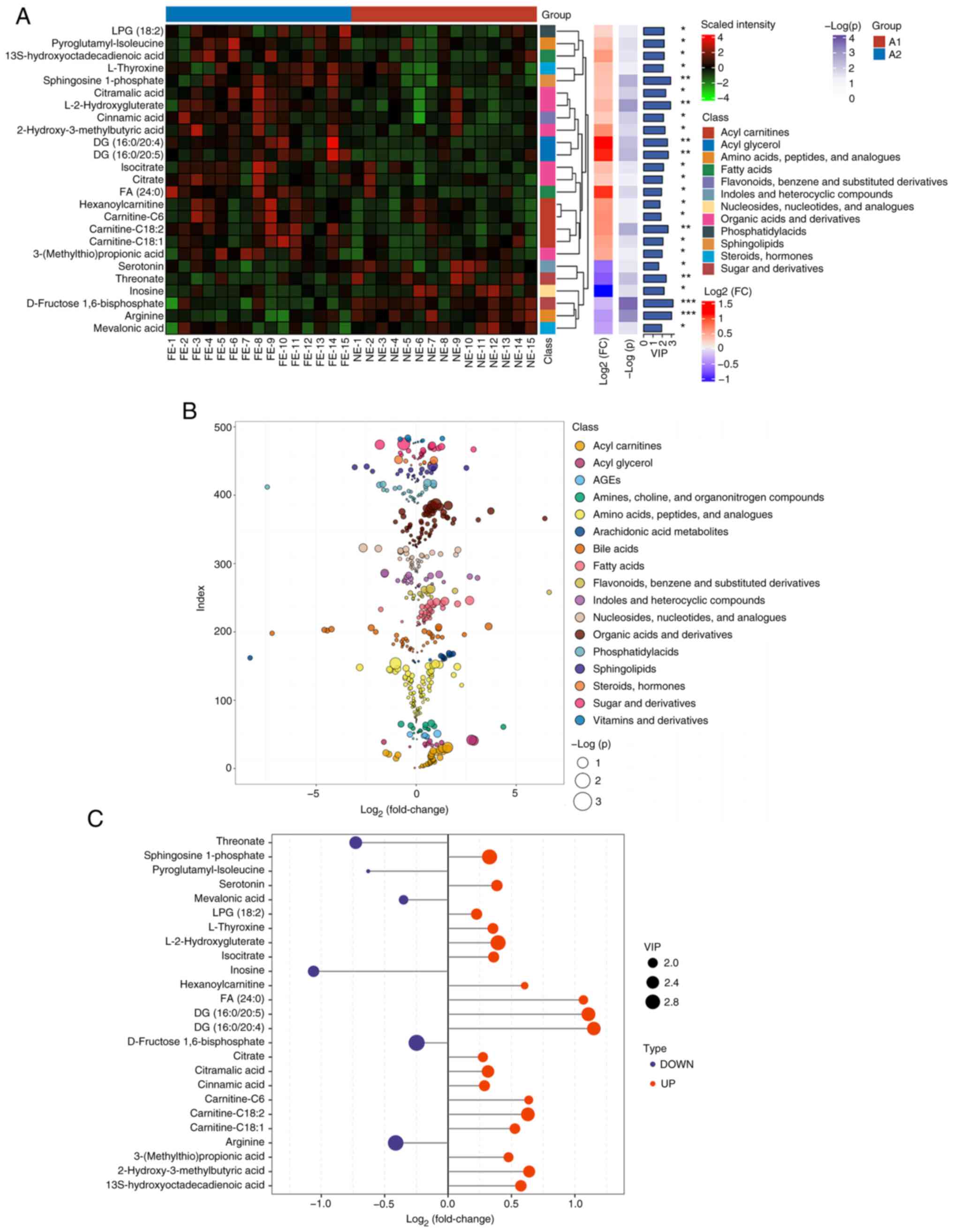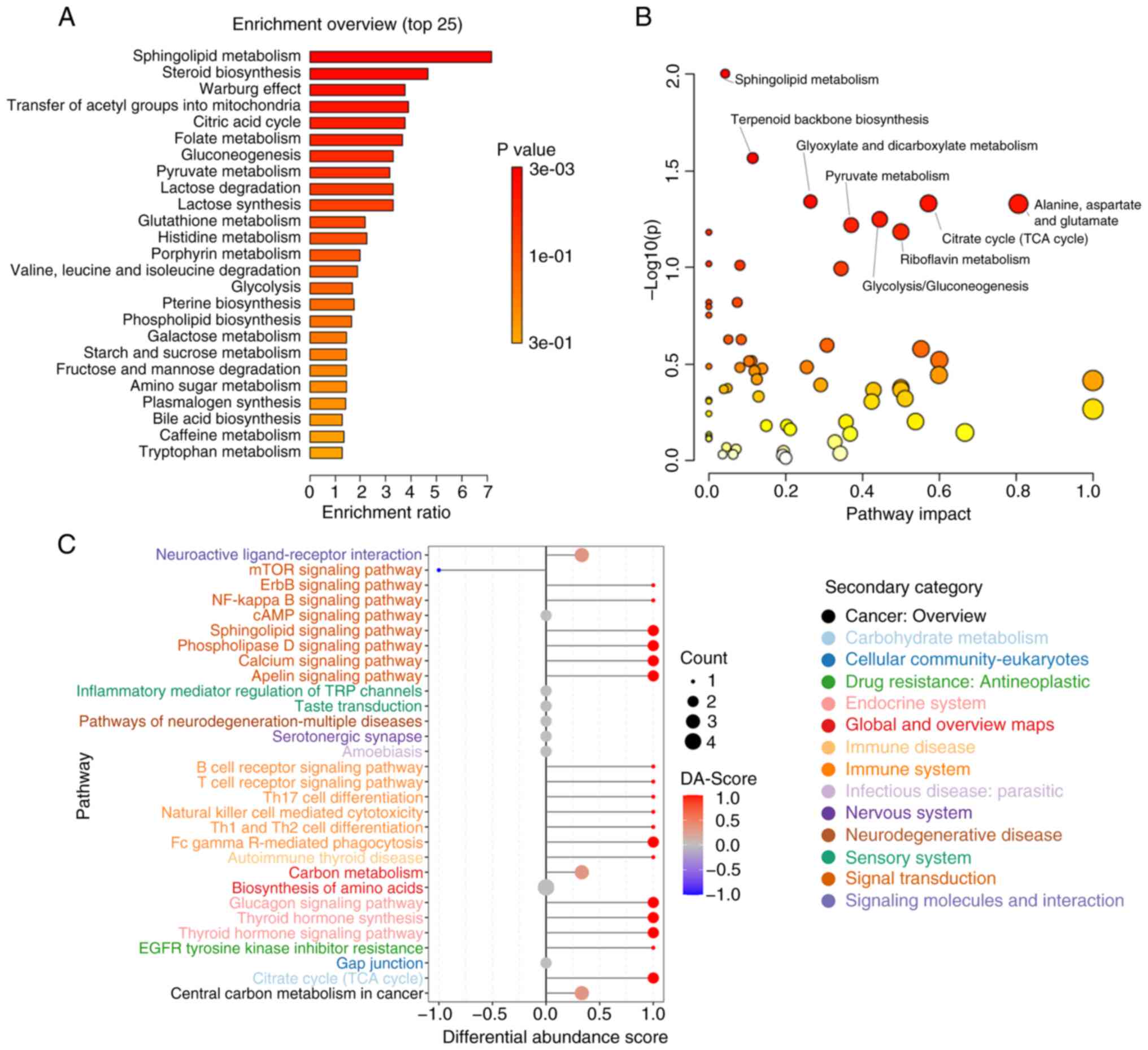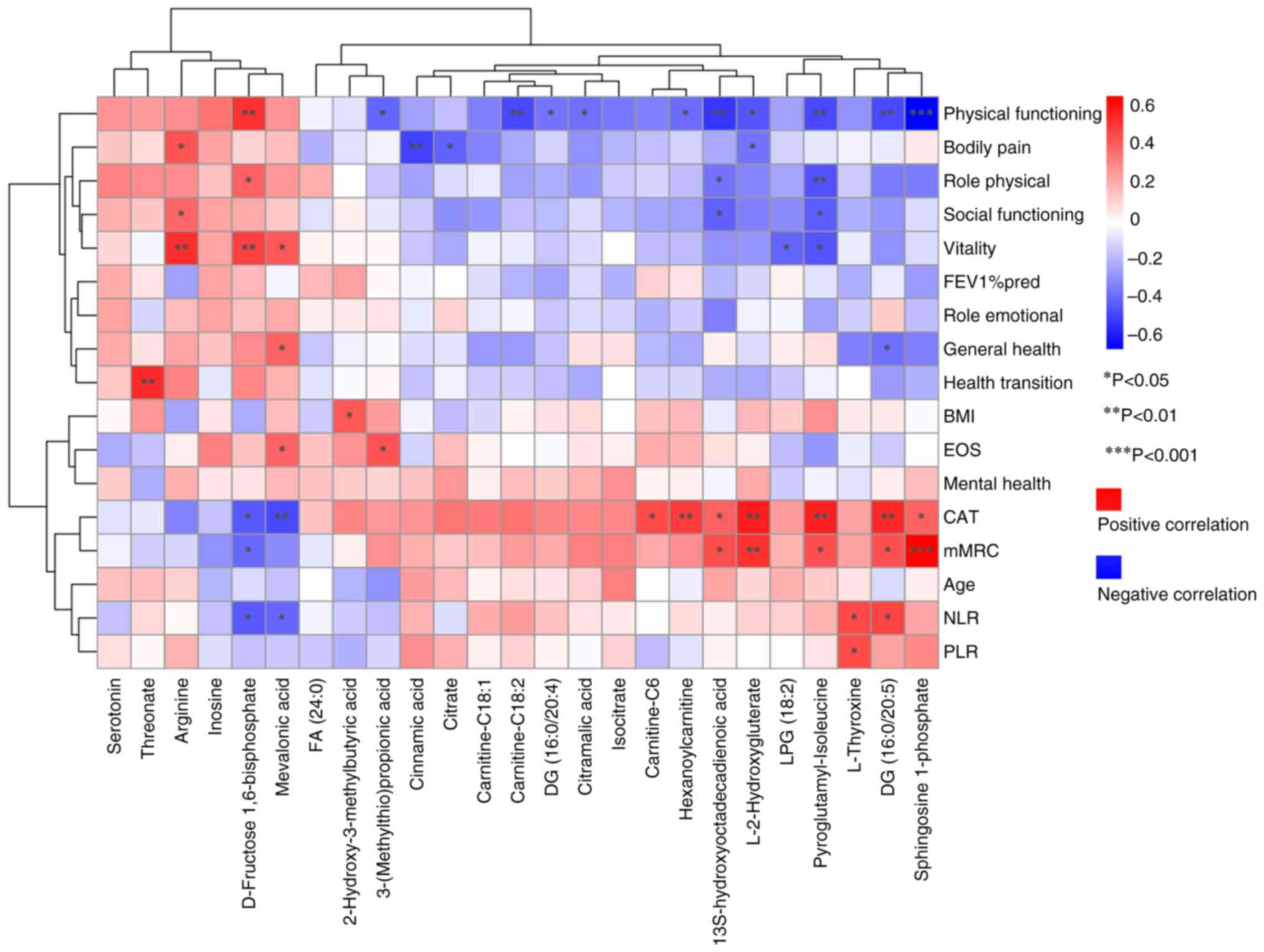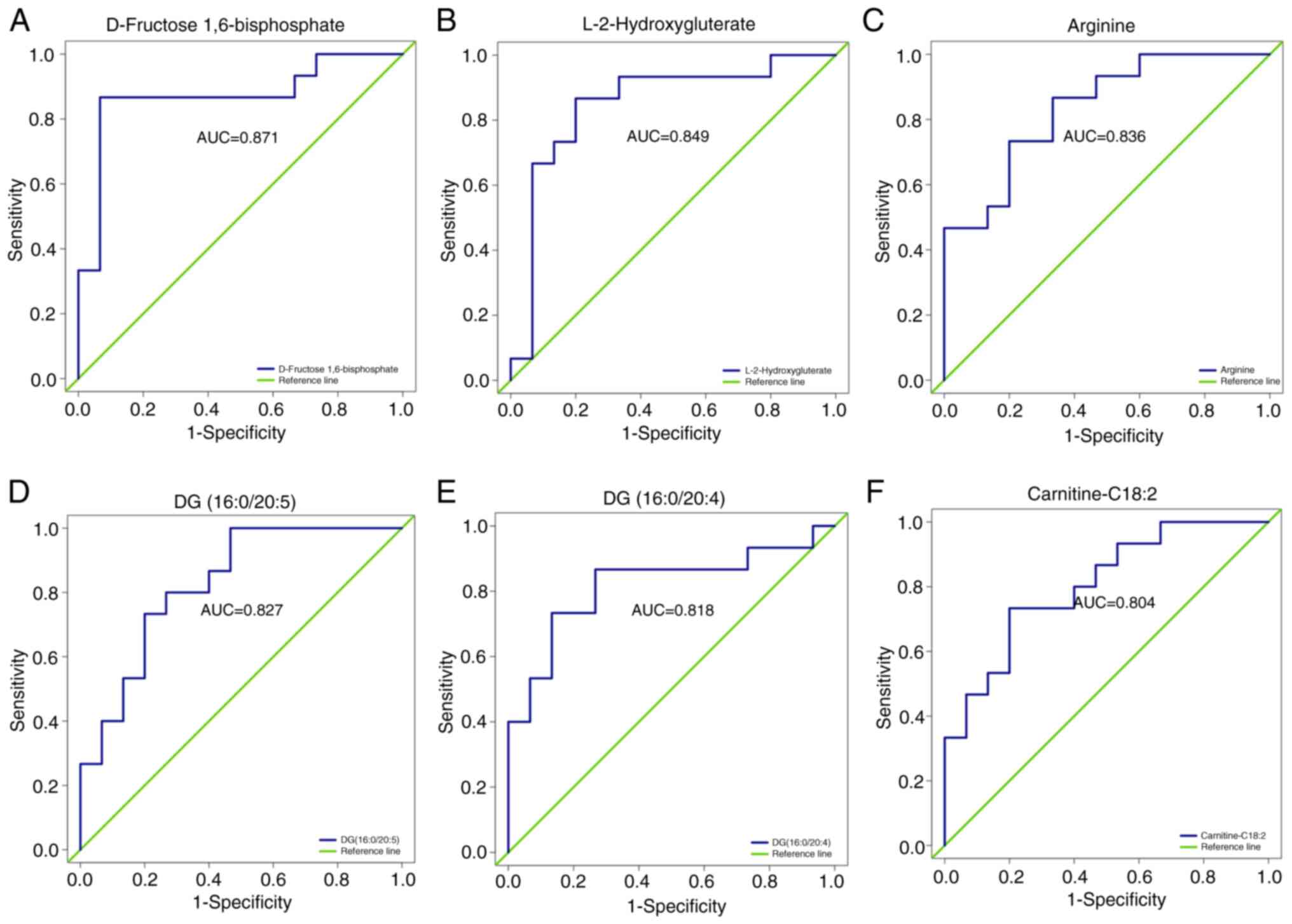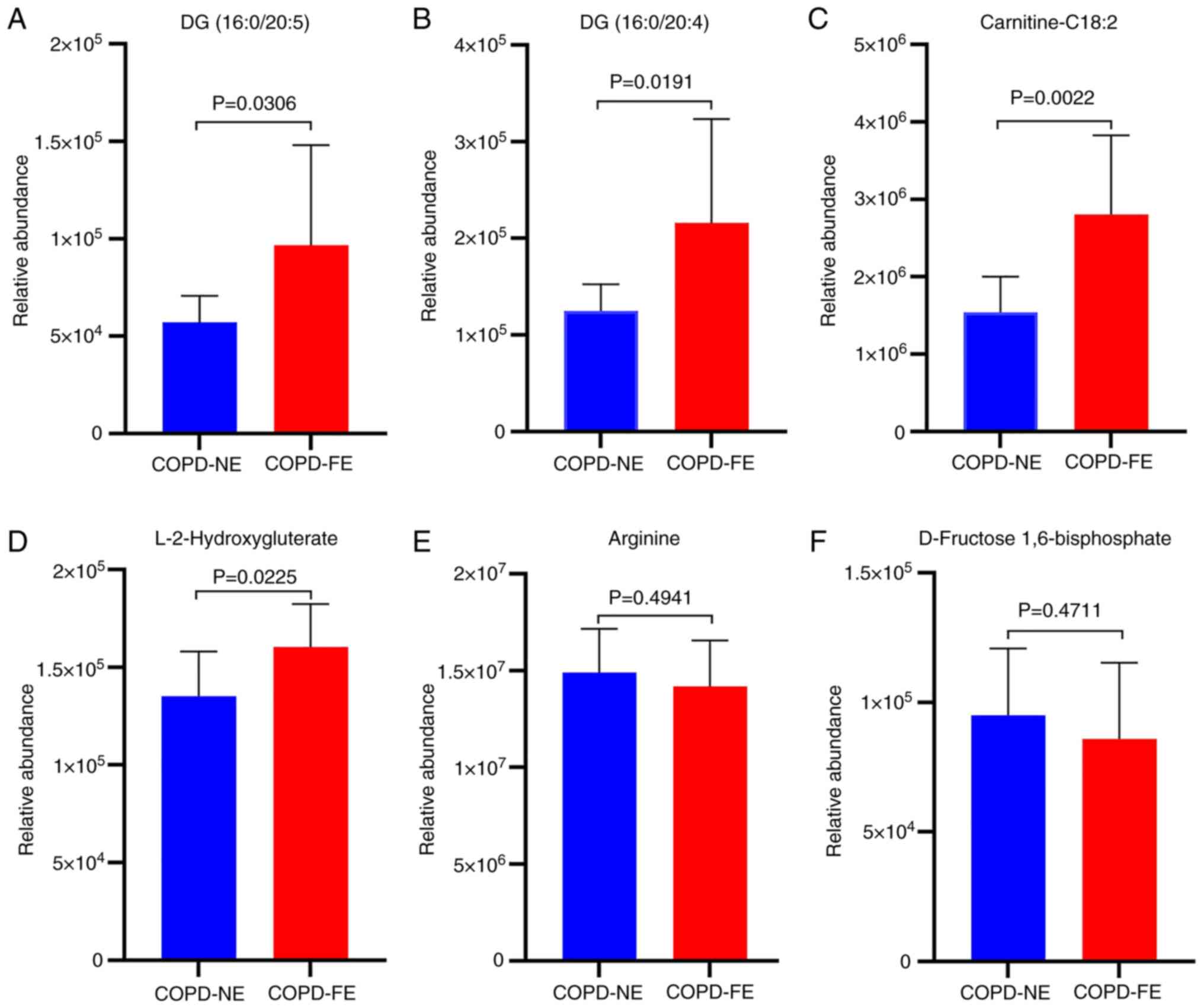|
1
|
Global Initiative for Chronic Obstructive
Lung Disease (GOLD), . Global strategy for the diagnosis,
management and prevention of chronic obstructive pulmonary disease:
2020 report. GOLD; Fontana, WI: 2020, https://goldcopd.org/wp-content/uploads/2019/12/GOLD-2020-FINAL-ver1.2-03Dec19_WMV.pdfFebruary
15–2020
|
|
2
|
Hurst JR, Vestbo J, Anzueto A, Locantore
N, Müllerova H, Tal-Singer R, Miller B, Lomas DA, Agusti A, Macnee
W, et al: Susceptibility to exacerbation in chronic obstructive
pulmonary disease. N Engl J Med. 363:1128–1138. 2010. View Article : Google Scholar : PubMed/NCBI
|
|
3
|
Dransfield MT, Kunisaki KM, Strand MJ,
Anzueto A, Bhatt SP, Bowler RP, Criner GJ, Curtis JL, Hanania NA,
Nath H, et al: Acute exacerbations and lung function loss in
smokers with and without chronic obstructive pulmonary disease. Am
J Respir Crit Care Med. 195:324–330. 2017. View Article : Google Scholar : PubMed/NCBI
|
|
4
|
Wedzicha JA and Seemungal TA: COPD
exacerbations: Defining their cause and prevention. Lancet.
370:786–796. 2007. View Article : Google Scholar : PubMed/NCBI
|
|
5
|
France G, Orme MW, Greening NJ, Steiner
MC, Chaplin EJ, Clinch L and Singh SJ: Cognitive function following
pulmonary rehabilitation and post-discharge recovery from
exacerbation in people with COPD. Respir Med. 176:1062492021.
View Article : Google Scholar : PubMed/NCBI
|
|
6
|
Camac ER, Voelker H and Criner GJ; COPD
Clinical Research Network and the Canadian Institutes of Health
Research, : Impact of COPD exacerbations leading to hospitalization
on general and disease-specific quality of life. Respir Med.
186:1065262021. View Article : Google Scholar : PubMed/NCBI
|
|
7
|
Hallin R, Koivisto-Hursti UK, Lindberg E
and Janson C: Nutritional status, dietary energy intake and the
risk of exacerbations in patients with chronic obstructive
pulmonary disease (COPD). Respir Med. 100:561–567. 2006. View Article : Google Scholar : PubMed/NCBI
|
|
8
|
Asai N, Ohkuni Y, Ohashi W and Kaneko N:
Modified MRC assessment and FEV1.0 can predict frequent acute
exacerbation of COPD: An observational prospective cohort study at
a single-center in Japan. Respir Med. 212:1072182023. View Article : Google Scholar : PubMed/NCBI
|
|
9
|
Cen J and Weng L: Comparison of peak
expiratory Flow(PEF) and COPD assessment test (CAT) to assess COPD
exacerbation requiring hospitalization: A prospective observational
study. Chron Respir Dis. 19:147997312210818592022. View Article : Google Scholar : PubMed/NCBI
|
|
10
|
Wu JJ, Xu HR, Zhang YX, Li YX, Yu HY,
Jiang LD, Wang CX and Han M: The characteristics of the frequent
exacerbator with chronic bronchitis phenotype and non-exacerbator
phenotype in patients with chronic obstructive pulmonary disease: A
meta-analysis and system review. BMC Pulm Med. 20:1032020.
View Article : Google Scholar : PubMed/NCBI
|
|
11
|
Liu X, Ge H, Feng X, Hang J, Zhang F, Jin
X, Bao H, Zhou M, Han F, Li S, et al: The combination of hemogram
indexes to predict exacerbation in stable chronic obstructive
pulmonary disease. Front Med (Lausanne). 7:5724352020. View Article : Google Scholar : PubMed/NCBI
|
|
12
|
Chen W, Gong L, Guo Z, Wang W, Zhang H,
Liu X, Yu S, Xiong L and Luo J: A novel integrated method for
large-scale detection, identification, and quantification of widely
targeted metabolites: Application in the study of rice
metabolomics. Mol Plant. 6:1769–1780. 2013. View Article : Google Scholar : PubMed/NCBI
|
|
13
|
Li Q and Song J: Analysis of widely
targeted metabolites of the euhalophyte Suaeda salsa under saline
conditions provides new insights into salt tolerance and
nutritional value in halophytic species. BMC Plant Biol.
19:3882019. View Article : Google Scholar : PubMed/NCBI
|
|
14
|
Sun T, Ding ZX, Luo X, Liu QS and Cheng Y:
Blood exosomes have neuroprotective effects in a mouse model of
Parkinson's disease. Oxid Med Cell Longev. 2020:38074762020.
View Article : Google Scholar : PubMed/NCBI
|
|
15
|
Peng L, You H, Xu MY, Dong ZY, Liu M, Jin
WJ and Zhou C: A novel metabolic score for predicting the acute
exacerbation in patients with chronic obstructive pulmonary
disease. Int J Chron Obstruct Pulmon Dis. 18:785–795. 2023.
View Article : Google Scholar : PubMed/NCBI
|
|
16
|
Kim J, Suresh B, Lim MN, Hong SH, Kim KS,
Song HE, Lee HY, Yoo HJ and Kim WJ: Metabolomics reveals
dysregulated sphingolipid and amino acid metabolism associated with
chronic obstructive pulmonary disease. Int J Chron Obstruct Pulmon
Dis. 17:2343–2353. 2022. View Article : Google Scholar : PubMed/NCBI
|
|
17
|
Gai X, Guo C, Zhang L, Zhang L, Abulikemu
M, Wang J, Zhou Q, Chen Y, Sun Y and Chang C: Serum
glycerophospholipid profile in acute exacerbation of chronic
obstructive pulmonary disease. Front Physiol. 12:6460102021.
View Article : Google Scholar : PubMed/NCBI
|
|
18
|
Liu X, Zhang H, Si Y, Du Y, Wu J and Li J:
High-coverage lipidomics analysis reveals biomarkers for diagnosis
of acute exacerbation of chronic obstructive pulmonary disease. J
Chromatogr B Analyt Technol Biomed Life Sci. 1201–1202.
1232782022.PubMed/NCBI
|
|
19
|
Singanayagam A, Loo SL, Calderazzo M,
Finney LJ, Trujillo Torralbo MB, Bakhsoliani E, Girkin J, Veerati
P, Pathinayake PS, Nichol KS, et al: Antiviral immunity is impaired
in COPD patients with frequent exacerbations. Am J Physiol Lung
Cell Mol Physiol. 317:L893–L903. 2019. View Article : Google Scholar : PubMed/NCBI
|
|
20
|
Lenferink A, Brusse-Keizer M, van der Valk
PD, Frith PA, Zwerink M, Monninkhof EM, van der Palen J and Effing
TW: Self-management interventions including action plans for
exacerbations versus usual care in patients with chronic
obstructive pulmonary disease. Cochrane Database Syst Rev.
8:CD0116822017.PubMed/NCBI
|
|
21
|
Wang R, Wu C, Zhao Y, Yan X, Ma X, Wu M,
Liu W, Gu Z, Zhao J and He J: Health related quality of life
measured by SF-36: A population-based study in Shanghai, China. BMC
Public Health. 8:2922008. View Article : Google Scholar : PubMed/NCBI
|
|
22
|
Christenson SA, Smith BM, Bafadhel M and
Putcha N: Chronic obstructive pulmonary disease. Lancet.
399:2227–2242. 2022. View Article : Google Scholar : PubMed/NCBI
|
|
23
|
Hannun YA and Obeid LM: Sphingolipids and
their metabolism in physiology and disease. Nat Rev Mol Cell Biol.
19:175–191. 2018. View Article : Google Scholar : PubMed/NCBI
|
|
24
|
Ammit AJ, Hastie AT, Edsall LC, Hoffman
RK, Amrani Y, Krymskaya VP, Kane SA, Peters SP, Penn RB, Spiegel S
and Panettieri RA Jr: Sphingosine 1-phosphate modulates human
airway smooth muscle cell functions that promote inflammation and
airway remodeling in asthma. FASEB J. 15:1212–1214. 2001.
View Article : Google Scholar : PubMed/NCBI
|
|
25
|
Jolly PS, Rosenfeldt HM, Milstien S and
Spiegel S: The roles of sphingosine-1-phosphate in asthma. Mol
Immunol. 38:1239–1245. 2002. View Article : Google Scholar : PubMed/NCBI
|
|
26
|
Helke K, Angel P, Lu P, Garrett-Mayer E,
Ogretmen B, Drake R and Voelkel-Johnson C: Ceramide synthase 6
deficiency enhances inflammation in the DSS model of colitis. Sci
Rep. 8:16272018. View Article : Google Scholar : PubMed/NCBI
|
|
27
|
Bowler RP, Jacobson S, Cruickshank C,
Hughes GJ, Siska C, Ory DS, Petrache I, Schaffer JE, Reisdorph N
and Kechris K: Plasma sphingolipids associated with chronic
obstructive pulmonary disease phenotypes. Am J Respir Crit Care
Med. 191:275–284. 2015. View Article : Google Scholar : PubMed/NCBI
|
|
28
|
Belchamber KBR, Singh R, Batista CM, Whyte
MK, Dockrell DH, Kilty I, Robinson MJ, Wedzicha JA, Barnes PJ and
Donnelly LE; COPD-MAP consortium, : Defective bacterial
phagocytosis is associated with dysfunctional mitochondria in COPD
macrophages. Eur Respir J. 54:18022442019. View Article : Google Scholar : PubMed/NCBI
|
|
29
|
Haji G, Wiegman CH, Michaeloudes C, Patel
MS, Curtis K, Bhavsar P, Polkey MI, Adcock IM and Chung KF; COPDMAP
consortium, : Mitochondrial dysfunction in airways and quadriceps
muscle of patients with chronic obstructive pulmonary disease.
Respir Res. 21:2622020. View Article : Google Scholar : PubMed/NCBI
|
|
30
|
Zhou WC, Qu J, Xie SY, Sun Y and Yao HW:
Mitochondrial dysfunction in chronic respiratory diseases:
Implications for the pathogenesis and potential therapeutics. Oxid
Med Cell Longev. 2021:51883062021. View Article : Google Scholar : PubMed/NCBI
|
|
31
|
Martínez-Reyes I and Chandel NS:
Mitochondrial TCA cycle metabolites control physiology and disease.
Nat Commun. 11:1022020. View Article : Google Scholar : PubMed/NCBI
|
|
32
|
Pålsson-McDermott EM and O'Neill LAJ:
Targeting immunometabolism as an anti-inflammatory strategy. Cell
Res. 30:300–314. 2020. View Article : Google Scholar : PubMed/NCBI
|
|
33
|
Finamore P, Lattanzi G, Pedone C, Poci S,
Alma A, Scarlata S, Fontana DO, Khazrai YM and Incalzi RA: Energy
expenditure and intake in COPD: The extent of unnoticed unbalance
by predicting REE. Respir Med. 201:1069512022. View Article : Google Scholar : PubMed/NCBI
|
|
34
|
Naz S, Kolmert J, Yang M, Reinke SN,
Kamleh MA, Snowden S, Heyder T, Levänen B, Erle DJ, Sköld CM, et
al: Metabolomics analysis identifies sex-associated metabotypes of
oxidative stress and the autotaxin-lysoPA axis in COPD. Eur Respir
J. 49:16023222017. View Article : Google Scholar : PubMed/NCBI
|
|
35
|
Xue M, Zeng Y, Lin R, Qu HQ, Zhang T,
Zhang XD, Liang Y, Zhen Y, Chen H, Huang Z, et al: Metabolomic
profiling of anaerobic and aerobic energy metabolic pathways in
chronic obstructive pulmonary disease. Exp Biol Med (Maywood).
246:1586–1596. 2021. View Article : Google Scholar : PubMed/NCBI
|
|
36
|
Pinto-Plata V, Casanova C, Divo M,
Tesfaigzi Y, Calhoun V, Sui J, Polverino F, Priolo C, Petersen H,
de Torres JP, et al: Plasma metabolomics and clinical predictors of
survival differences in COPD patients. Respir Res. 20:2192019.
View Article : Google Scholar : PubMed/NCBI
|
|
37
|
Zhou J, Li Q, Liu C, Pang R and Yin Y:
Plasma metabolomics and lipidomics reveal perturbed metabolites in
different disease stages of chronic obstructive pulmonary disease.
Int J Chron Obstruct Pulmon Dis. 15:553–565. 2020. View Article : Google Scholar : PubMed/NCBI
|
|
38
|
Engelen MPKJ and Schols AMWJ: Altered
amino acid metabolism in chronic obstructive pulmonary disease: New
therapeutic perspective? Curr Opin Clin Nutr Metab Care. 6:73–78.
2003. View Article : Google Scholar : PubMed/NCBI
|
|
39
|
Labaki WW, Gu T, Murray S, Curtis JL,
Yeomans L, Bowler RP, Barr RG, Comellas AP, Hansel NN, Cooper CB,
et al: Serum amino acid concentrations and clinical outcomes in
smokers: SPIROMICS metabolomics study. Sci Rep. 9:113672019.
View Article : Google Scholar : PubMed/NCBI
|
|
40
|
Pouw EM, Schols AM, Deutz NE and Wouters
EF: Plasma and muscle amino acid levels in relation to resting
energy expenditure and inflammation in stable chronic obstructive
pulmonary disease. Am J Respir Crit Care Med. 158:797–801. 1998.
View Article : Google Scholar : PubMed/NCBI
|
|
41
|
Sivakumar R, Babu PV and Shyamaladevi CS:
Aspartate and glutamate prevents isoproterenol-induced cardiac
toxicity by alleviating oxidative stress in rats. Exp Toxicol
Pathol. 63:137–142. 2011. View Article : Google Scholar : PubMed/NCBI
|
|
42
|
Rus A, Peinado MA, Castro L and Del Moral
ML: Lung eNOS and iNOS are reoxygenation time-dependent upregulated
after acute hypoxia. Anat Rec (Hoboken). 293:1089–1098. 2010.
View Article : Google Scholar : PubMed/NCBI
|
|
43
|
Caldwell RB, Toque HA, Narayanan SP and
Caldwell RW: Arginase: An old enzyme with new tricks. Trends
Pharmacol Sci. 36:395–405. 2015. View Article : Google Scholar : PubMed/NCBI
|
|
44
|
Bulau P, Zakrzewicz D, Kitowska K, Leiper
J, Gunther A, Grimminger F and Eickelberg O: Analysis of
methylarginine metabolism in the cardiovascular system identifies
the lung as a major source of ADMA. Am J Physiol Lung Cell Mol
Physiol. 292:L18–L24. 2007. View Article : Google Scholar : PubMed/NCBI
|
|
45
|
Mieulet V, Yan L, Choisy C, Sully K,
Procter J, Kouroumalis A, Krywawych S, Pende M, Ley SC, Moinard C
and Lamb RF: TPL-2-mediated activation of MAPK downstream of TLR4
signaling is coupled to arginine availability. Sci Signal.
3:ra612010. View Article : Google Scholar : PubMed/NCBI
|
|
46
|
Zea AH, Rodriguez PC, Culotta KS,
Hernandez CP, DeSalvo J, Ochoa JB, Park HJ, Zabaleta J and Ochoa
AC: L-Arginine modulates CD3zeta expression and T cell function in
activated human T lymphocytes. Cell Immunol. 232:21–31. 2004.
View Article : Google Scholar : PubMed/NCBI
|
|
47
|
Pera T, Zuidhof AB, Smit M, Menzen MH,
Klein T, Flik G, Zaagsma J, Meurs H and Maarsingh H: Arginase
inhibition prevents inflammation and remodeling in a guinea pig
model of chronic obstructive pulmonary disease. J Pharmacol Exp
Ther. 349:229–238. 2014. View Article : Google Scholar : PubMed/NCBI
|
|
48
|
Rathor VPS, Chugh P, Ali R, Bhatnagar A,
Haque SE, Bhatnagar A and Mittal G: Formulation, preclinical and
clinical evaluation of a new submicronic arginine respiratory fluid
for treatment of chronic obstructive pulmonary disorder. Saudi
Pharm J. 24:49–56. 2016. View Article : Google Scholar : PubMed/NCBI
|
|
49
|
Anderson CL, Shen L, Eicher DM, Wewers MD
and Gill JK: Phagocytosis mediated by three distinct Fc gamma
receptor classes on human leukocytes. J Exp Med. 171:1333–1345.
1990. View Article : Google Scholar : PubMed/NCBI
|
|
50
|
Dietrich A, Steinritz D and Gudermann T:
Transient receptor potential (TRP) channels as molecular targets in
lung toxicology and associated diseases. Cell Calcium. 67:123–137.
2017. View Article : Google Scholar : PubMed/NCBI
|
|
51
|
Takahashi N, Kozai D, Kobayashi R, Ebert M
and Mori Y: Roles of TRPM2 in oxidative stress. Cell Calcium.
50:279–287. 2011. View Article : Google Scholar : PubMed/NCBI
|
|
52
|
Khalil M, Alliger K, Weidinger C, Yerinde
C, Wirtz S, Becker C and Engel MA: Functional role of transient
receptor potential channels in immune cells and epithelia. Front
Immunol. 9:1742018. View Article : Google Scholar : PubMed/NCBI
|
|
53
|
Ebenezer DL, Fu P, Suryadevara V, Zhao Y
and Natarajan V: Epigenetic regulation of pro-inflammatory cytokine
secretion by sphingosine 1-phosphate (S1P) in acute lung injury:
Role of S1P lyase. Adv Biol Regul. 63:156–166. 2017. View Article : Google Scholar : PubMed/NCBI
|
|
54
|
Wadgaonkar R, Patel V, Grinkina N, Romano
C, Liu J, Zhao Y, Sammani S, Garcia JG and Natarajan V:
Differential regulation of sphingosine kinases 1 and 2 in lung
injury. Am J Physiol Lung Cell Mol Physiol. 296:L603–L613. 2009.
View Article : Google Scholar : PubMed/NCBI
|
|
55
|
Feng A, Rice AD, Zhang Y, Kelly GT, Zhou T
and Wang T: S1PR1-associated molecular signature predicts survival
in patients with sepsis. Shock. 53:284–292. 2020. View Article : Google Scholar : PubMed/NCBI
|
|
56
|
Mohammed S, Bindu A, Viswanathan A and
Harikumar KB: Sphingosine 1-phosphate signaling during infection
and immunity. Prog Lipid Res. 92:1012512023. View Article : Google Scholar : PubMed/NCBI
|
|
57
|
Zhang L, Liu J, Xiao E, Han Q and Wang L:
Sphingosine-1-phosphate related signalling pathways manipulating
virus replication. Rev Med Virol. 33:e24152023. View Article : Google Scholar : PubMed/NCBI
|
|
58
|
Monick MM, Cameron K, Powers LS, Butler
NS, McCoy D, Mallampalli RK and Hunninghake GW: Sphingosine kinase
mediates activation of extracellular signal-related kinase and Akt
by respiratory syncytial virus. Am J Respir Cell Mol Biol.
30:844–852. 2004. View Article : Google Scholar : PubMed/NCBI
|
|
59
|
Thomas KW, Monick MM, Staber JM,
Yarovinsky T, Carter AB and Hunninghake GW: Respiratory syncytial
virus inhibits apoptosis and induces NF-kappa B activity through a
phosphatidylinositol 3-kinase-dependent pathway. J Biol Chem.
277:492–501. 2002. View Article : Google Scholar : PubMed/NCBI
|
|
60
|
Obinata H and Hla T: Sphingosine
1-phosphate and inflammation. Int Immunol. 31:617–625. 2019.
View Article : Google Scholar : PubMed/NCBI
|
|
61
|
Lee H, Deng J, Kujawski M, Yang C, Liu Y,
Herrmann A, Kortylewski M, Horne D, Somlo G, Forman S, et al:
STAT3-induced S1PR1 expression is crucial for persistent STAT3
activation in tumors. Nat Med. 16:1421–1428. 2010. View Article : Google Scholar : PubMed/NCBI
|
|
62
|
Hou L, Zhang Z, Yang L, Chang N, Zhao X,
Zhou X, Yang L and Li L: NLRP3 inflammasome priming and activation
in cholestatic liver injury via the sphingosine 1-phosphate/S1P
receptor 2/Gα(12/13)/MAPK signaling pathway. J Mol Med
(Berl). 99:273–288. 2021. View Article : Google Scholar : PubMed/NCBI
|
|
63
|
Zhang M, Hei R, Zhou Z, Xiao W, Liu X and
Chen Y: Macrophage polarization involved the inflammation of
chronic obstructive pulmonary disease by S1P/HDAC1 signaling. Am J
Cancer Res. 13:4478–4489. 2023.PubMed/NCBI
|
|
64
|
De Cunto G, Brancaleone V, Riemma MA,
Cerqua I, Vellecco V, Spaziano G, Cavarra E, Bartalesi B,
D'Agostino B, Lungarella G, et al: Functional contribution of
sphingosine-1-phosphate to airway pathology in cigarette
smoke-exposed mice. Br J Pharmacol. 177:267–281. 2020. View Article : Google Scholar : PubMed/NCBI
|
|
65
|
Oldham WM, Clish CB, Yang Y and Loscalzo
J: Hypoxia-mediated increases in L-2-hydroxyglutarate coordinate
the metabolic response to reductive stress. Cell Metab. 22:291–303.
2015. View Article : Google Scholar : PubMed/NCBI
|
|
66
|
Intlekofer AM, Dematteo RG, Venneti S,
Finley LW, Lu C, Judkins AR, Rustenburg AS, Grinaway PB, Chodera
JD, Cross JR and Thompson CB: Hypoxia induces production of
L-2-hydroxyglutarate. Cell Metab. 22:304–311. 2015. View Article : Google Scholar : PubMed/NCBI
|
|
67
|
Intlekofer AM, Wang B, Liu H, Shah H,
Carmona-Fontaine C, Rustenburg AS, Salah S, Gunner MR, Chodera JD,
Cross JR and Thompson CB: L-2-Hydroxyglutarate production arises
from noncanonical enzyme function at acidic pH. Nat Chem Biol.
13:494–500. 2017. View Article : Google Scholar : PubMed/NCBI
|
|
68
|
Steinert EM, Vasan K and Chandel NS:
Mitochondrial metabolism regulation of T cell-mediated immunity.
Annu Rev Immunol. 39:395–416. 2021. View Article : Google Scholar : PubMed/NCBI
|
|
69
|
Williams NC, Ryan DG, Costa ASH, Mills EL,
Jedrychowski MP, Cloonan SM, Frezza C and O'Neill LA: Signaling
metabolite L-2-hydroxyglutarate activates the transcription factor
HIF-1α in lipopolysaccharide-activated macrophages. J Biol Chem.
298:1015012022. View Article : Google Scholar : PubMed/NCBI
|
|
70
|
Almannai M, Alfadhel M and El-Hattab AW:
Carnitine inborn errors of metabolism. Molecules. 24:32512019.
View Article : Google Scholar : PubMed/NCBI
|
|
71
|
Wang Y, Li P, Cao Y, Liu C, Wang J and Wu
W: Skeletal muscle mitochondrial dysfunction in chronic obstructive
pulmonary disease: Underlying mechanisms and physical therapy
perspectives. Aging Dis. 14:33–45. 2023. View Article : Google Scholar : PubMed/NCBI
|
|
72
|
Conlon TM, Bartel J, Ballweg K, Günter S,
Prehn C, Krumsiek J, Meiners S, Theis FJ, Adamski J, Eickelberg O
and Yildirim AÖ: Metabolomics screening identifies reduced
L-carnitine to be associated with progressive emphysema. Clin Sci
(Lond). 130:273–287. 2016. View Article : Google Scholar : PubMed/NCBI
|
|
73
|
Nicholas DA, Proctor EA, Agrawal M,
Belkina AC, Van Nostrand SC, Panneerseelan-Bharath L, Jones AR IV,
Raval F, Ip BC, Zhu M, et al: Fatty Acid metabolites combine with
reduced β oxidation to activate Th17 inflammation in human type 2
diabetes. Cell Metab. 30:447–461.e5. 2019. View Article : Google Scholar : PubMed/NCBI
|
|
74
|
Aguer C, McCoin CS, Knotts TA, Thrush AB,
Ono-Moore K, McPherson R, Dent R, Hwang DH, Adams SH and Harper ME:
Acylcarnitines: Potential implications for skeletal muscle insulin
resistance. FASEB J. 29:336–345. 2015. View Article : Google Scholar : PubMed/NCBI
|
|
75
|
Okutan O, Kartaloglu Z, Onde ME, Bozkanat
E and Kunter E: Pulmonary function tests and thyroid hormone
concentrations in patients with chronic obstructive pulmonary
disease. Med Princ Pract. 13:126–128. 2004. View Article : Google Scholar : PubMed/NCBI
|
|
76
|
Alshamari AHI, Deli F, Kadhum HI and
Kadhim IJ: Assessment of thyroid function tests in patients with
chronic obstructive pulmonary disease. J Med Life. 15:1532–1535.
2022. View Article : Google Scholar : PubMed/NCBI
|
|
77
|
Dimopoulou I, Ilias I, Mastorakos G,
Mantzos E, Roussos C and Koutras DA: Effects of severity of chronic
obstructive pulmonary disease on thyroid function. Metabolism.
50:1397–1401. 2001. View Article : Google Scholar : PubMed/NCBI
|
|
78
|
Dekkers BGJ, Naeimi S, Bos IST, Menzen MH,
Halayko AJ, Hashjin GS and Meurs H: L-thyroxine promotes a
proliferative airway smooth muscle phenotype in the presence of
TGF-β1. Am J Physiol Lung Cell Mol Physiol. 308:L301–L306. 2015.
View Article : Google Scholar : PubMed/NCBI
|
|
79
|
Mancini A, Di Segni C, Raimondo S,
Olivieri G, Silvestrini A, Meucci E and Currò D: Thyroid hormones,
oxidative stress, and inflammation. Mediators Inflamm.
2016:67571542016. View Article : Google Scholar : PubMed/NCBI
|
|
80
|
Baldanzi G and Malerba M: DGKα in
neutrophil biology and its implications for respiratory diseases.
Int J Mol Sci. 20:56732019. View Article : Google Scholar : PubMed/NCBI
|
|
81
|
Shahnazari S, Namolovan A, Klionsky DJ and
Brumell JH: A role for diacylglycerol in antibacterial autophagy.
Autophagy. 7:331–333. 2011. View Article : Google Scholar : PubMed/NCBI
|
|
82
|
Yang J, Wang HX, Xie J, Li L, Wang J, Wan
ECK and Zhong XP: DGK α and ζ activities control TH1 and
TH17 cell differentiation. Front Immunol. 10:30482020.
View Article : Google Scholar : PubMed/NCBI
|
|
83
|
Cooke M and Kazanietz MG: Overarching
roles of diacylglycerol signaling in cancer development and
antitumor immunity. Sci Signal. 15:eabo02642022. View Article : Google Scholar : PubMed/NCBI
|
|
84
|
Fernie AR, Carrari F and Sweetlove LJ:
Respiratory metabolism: Glycolysis, the TCA cycle and mitochondrial
electron transport. Curr Opin Plant Biol. 7:254–261. 2004.
View Article : Google Scholar : PubMed/NCBI
|
|
85
|
Al-ani S, Spigt M, Hofset P and Melbye H:
Predictors of exacerbations of asthma and COPD during one year in
primary care. Fam Pract. 30:621–628. 2013. View Article : Google Scholar : PubMed/NCBI
|
|
86
|
Cruickshank-Quinn CI, Jacobson S, Hughes
G, Powell RL, Petrache I, Kechris K, Bowler R and Reisdorph N:
Metabolomics and transcriptomics pathway approach reveals
outcome-specific perturbations in COPD. Sci Rep. 8:171322018.
View Article : Google Scholar : PubMed/NCBI
|



